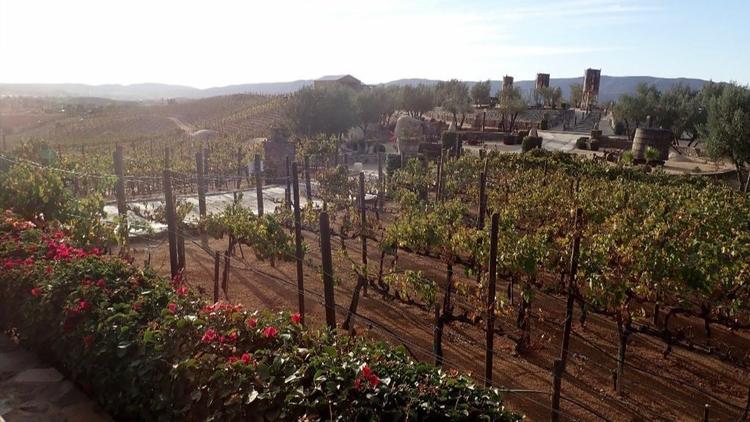A private company’s plan to take Tijuana wastewater, treat it to an advanced level, and pipe it to Baja California’s Guadalupe Valley aims at ending water shortages that confront the celebrated wine-producing region.
The proposal is expected to move forward within days as a group of Israeli and Mexican investors finalizes its contract with the state of Baja California to build a sewage treatment plant and a 65-mile aqueduct from southeastern Tijuana to the Guadalupe Valley.
The company, ODIS Asversa, is preparing to spend some $77 million on the project that would be the first in Mexico to use treated wastewater to irrigate vineyards.
The initial plan is to send about 23 million gallons per day of wastewater collected and treated in Tijuana to the Guadalupe Valley, said Fabián Yañez, who oversees operations in Latin America for ODIS, an Israeli company that specializes in treating wastewater and reusing it for irrigation.
“We are in the process of paperwork, defining the contract, the rules and conditions,” Germán Lizola, director of the Baja California Public Service Commission in Tijuana, or CESPT, said in an interview on Friday. “We expect that before the end of the month, the document will be ready to sign.”
The volume represents just under 30 percent of the 82 million gallons of wastewater produced daily by Tijuana, according to CESPT.
The company would purchase wastewater from CESPT, treat it, and deliver it to the Guadalupe Valley. The concept has been around for years, but it wasn’t until January that the state government put the project out to bid, and in April selected ODIS to build it.
The project comes as the aquifer that supplies water to the vineyards of the Guadalupe Valley has been overexploited, and growers have been searching for a new supply.
“We have reached a critical situation with the water issue,” Hans Backhoff, owner of the Monte Xanic winery, said earlier this month in Ensenada at a forum on water in the Guadalupe Valley organized by the Autonomous University of Baja California.
But some vintners remain wary of the project, fearing that the large delivery of water without proper controls could change the valley’s rural flavor. “You don’t want to create Las Vegas in the Guadalupe Valley, you don’t want to create Disneyland,” said Natalia Badan, owner of the Mogor-Badan winery. “This could be an enormous success or an enormous failure.”
The Guadalupe Valley would hardly be the first wine region to use treated wastewater in its vineyards. In California, the Napa Valley has done so for more than two decades, said Tim Healy, general manager of the Napa Sanitation District, at the tune of about 1 million gallons of water per day treated to a tertiary level.
“It’s a really good use of the water,” Healy said. “To take our water and treat it and put it into a river and have it go away is a terrible waste of resources.”
Yañez said the water delivered to the Guadalupe Valley would be treated at a level “a little bit higher” than that used in Napa. The treatment would involve “methods of much technological innovation patented in Israel,” he said , and “be much more advanced than tertiary level.”
ODIS Asversa’s Israeli and Mexican investors would fund 40 percent of the project, with the remainder financed through loans from Israel’s Bank Hipoalim and Mexico’s Bancomer, Yañez said.
“We are working at top speed with everything,” he said, putting priority on a contract “that is 100 percent bankable so that we can obtain the financing,” he said.
Yañez said the terms of the agreement are still being defined. Under one scenario, ODIS would take the treated effluent from two Tijuana plants, La Morita and Arturo Herrera — about 10 million gallons per day — and draw the rest of its supply from deliveries of untreated sewage water in Tijuana’s system, which would be piped to a plant built by ODIS at same eastern Tijuana location site as the La Morita plant.
But Yañez said that it is also looking at the possibility of taking all 23 million gallons per day of untreated wastewater directly from Tijuana’s system. “By Tuesday or Wednesday, we should have it defined,” he said.
The project comes more than a decade after a U.S. company, Bajagua, failed in its bid to build a treatment plant in Mexico with $170 million in U.S. government funds with the aim of selling up to 59 million gallons per day of reclaimed water. The proposal, which generated controversy north of the border, ultimately did not go through when the International Boundary and Water Commission instead decided to upgrade its existing San Ysidro plant, which treats 25 million gallons of Tijuana sewage per day.
The Guadalupe Valley recycling project comes as the issue of Tijuana wastewater has been in the spotlight amid growing outcry in San Diego County over sewage-contaminated cross-border flows that force the closure of beaches near the border.
“The difference between this and the Bajagua project is that it’s all private sector financing and it’s not going to cost taxpayers any money,” said Imperial Beach Mayor Serge Dedina, who was one of Bajagua’s staunchest opponents. “Finally you can monetize sewage and there is an incentive not to dump into the ocean.”
Imperial Beach has joined forces with Chula Vista and the Port of San Diego in a federal lawsuit that alleges the International Boundary and Water Commission has not done enough to prevent the cross-border sewage contamination.
To what extent the current private recycling effort could alleviate cross-border contamination is unclear. But CESPT’s Lizola said that it would end the flow of treated effluent from La Morita and Arturo Herrera plants that now is discharged into the Tijuana River channel and released into the Pacific Ocean south of the border.
Yañez expects that once the contract is signed, it would take up to 60 days to secure the loans and begin construction. Construction would take about 18 months, and without further hurdles, he expects the project could be completed in early 2020.
Twitter @sandradibble





